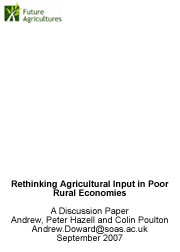By Andrew Dorward, Peter Hazell and Colin Poulton
September 2007
 As part of discussions on the future of pastoral production systems in East Africa there have been a number of recent interventions arguing that something urgently needs to be done to deal with a Malthusian style crisis in pastoral areas. In short, the argument goes, there are too many people which, combined with a declining (or not increasing) productivity of the natural resource base, means that not enough livestock can be kept to sustain a viable pastoral system.
As part of discussions on the future of pastoral production systems in East Africa there have been a number of recent interventions arguing that something urgently needs to be done to deal with a Malthusian style crisis in pastoral areas. In short, the argument goes, there are too many people which, combined with a declining (or not increasing) productivity of the natural resource base, means that not enough livestock can be kept to sustain a viable pastoral system.
This argument has been most eloquently and effectively argued by Stephen Sandford in “Too many people,too few livestock: the crisis affecting pastoralists in the Greater Horn of Africa”. This is a response to this piece, aimed at sparking a wider discussion.Such a discussion is urgently needed. For at the same time as the pessimistic prognoses about pastoralist futures in the Greater Horn of Africa, there has been, for the first time in several decades, a revival of interest in pastoralism and livestock production.
This takes two forms – one a celebration of the ‘pastoral way of life’ and the importance of indigenous systems of production and management1 and another focusing on the market potentials of a ‘livestock revolution’2. What should we make of these positions? What should the practical and policy responses be? Pastoral pessimism?
The arguments of Sandford (and others) put the more up-beat assessments in doubt. What are some of the major elements of the pastoral pessimists’ argument?
1. That people:livestock ratios have declined in pastoralist households to a levelbelow 3 TLUs/person, deemed to be a ‘viable’ amount for sustainablelivestock production, due to a combination of human population growth anddeclining rainfall.
2. That primary and secondary productivity (through range management,veterinary and other interventions) are not sufficient to make up the gap, andare unlikely to be so in the future.
3. That real prices of livestock products have not increased (and are unlikely to do so, despite growing demand) to compensate for lower numbers per household.
4. That, with small and decreasing herd/flock sizes, sales remain focused on immediate cash needs rather than ‘commercial’ off take.
5. That pastoral economies remain poor, associated with limited circulation of cash, and so have little opportunity for growth through linkages to other income earning activities.
6. That land for grazing and livestock production continues to be removed for cropping, and that this, particularly if supported by irrigation, is probably a better bet for many pastoralists anyway.
7. That for many the best option is exit, but in a way that does not involve destitution and displacement.
{jathumbnail off}
